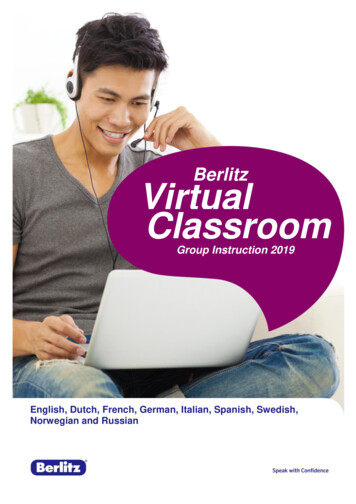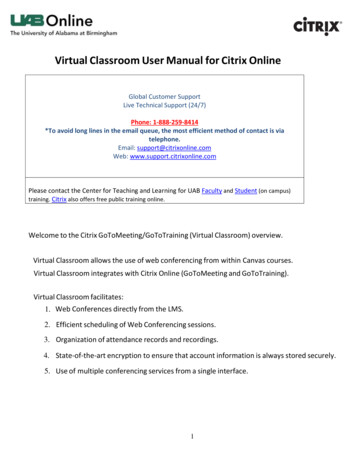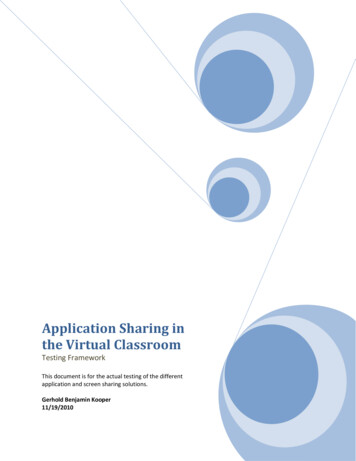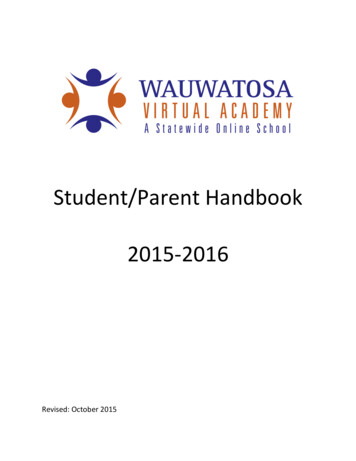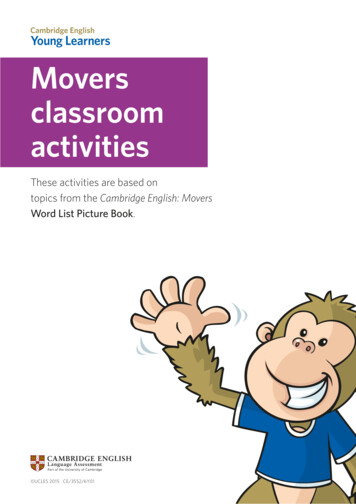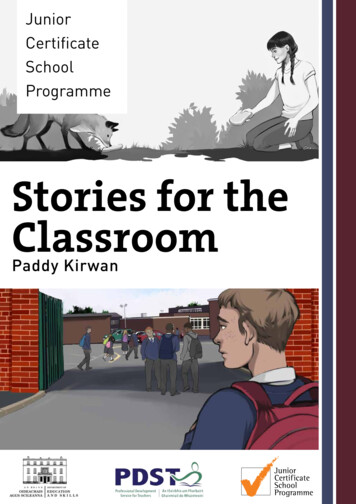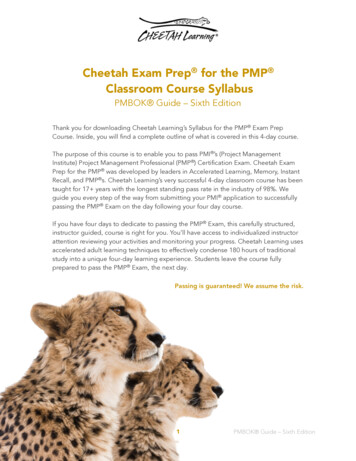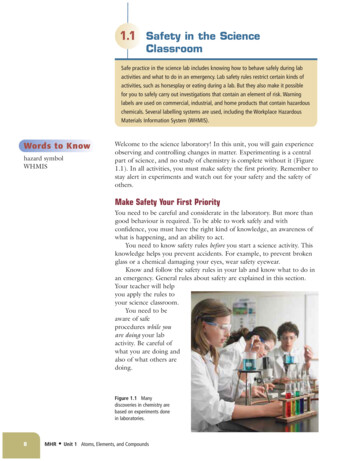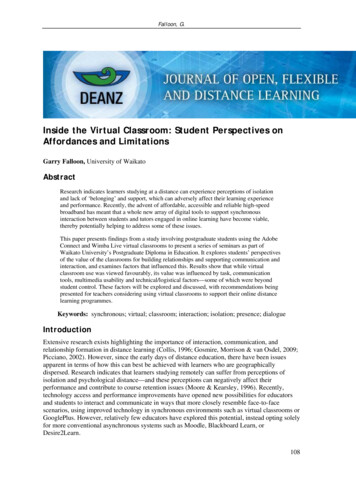
Transcription
Falloon, G.Inside the Virtual Classroom: Student Perspectives onAffordances and LimitationsGarry Falloon, University of WaikatoAbstractResearch indicates learners studying at a distance can experience perceptions of isolationand lack of ‘belonging’ and support, which can adversely affect their learning experienceand performance. Recently, the advent of affordable, accessible and reliable high-speedbroadband has meant that a whole new array of digital tools to support synchronousinteraction between students and tutors engaged in online learning have become viable,thereby potentially helping to address some of these issues.This paper presents findings from a study involving postgraduate students using the AdobeConnect and Wimba Live virtual classrooms to present a series of seminars as part ofWaikato University’s Postgraduate Diploma in Education. It explores students’ perspectivesof the value of the classrooms for building relationships and supporting communication andinteraction, and examines factors that influenced this. Results show that while virtualclassroom use was viewed favourably, its value was influenced by task, communicationtools, multimedia usability and technical/logistical factors—some of which were beyondstudent control. These factors will be explored and discussed, with recommendations beingpresented for teachers considering using virtual classrooms to support their online distancelearning programmes.Keywords: synchronous; virtual; classroom; interaction; isolation; presence; dialogueIntroductionExtensive research exists highlighting the importance of interaction, communication, andrelationship formation in distance learning (Collis, 1996; Gosmire, Morrison & van Osdel, 2009;Picciano, 2002). However, since the early days of distance education, there have been issuesapparent in terms of how this can best be achieved with learners who are geographicallydispersed. Research indicates that learners studying remotely can suffer from perceptions ofisolation and psychological distance—and these perceptions can negatively affect theirperformance and contribute to course retention issues (Moore & Kearsley, 1996). Recently,technology access and performance improvements have opened new possibilities for educatorsand students to interact and communicate in ways that more closely resemble face-to-facescenarios, using improved technology in synchronous environments such as virtual classrooms orGooglePlus. However, relatively few educators have explored this potential, instead opting solelyfor more conventional asynchronous systems such as Moodle, Blackboard Learn, orDesire2Learn.108
Journal of Open, Flexible, and Distance Learning, 16(1)This paper reports on the use of two examples of online virtual classrooms—Adobe Connect Proand Wimba Live Classroom (now Blackboard Collaborate)—in postgraduate educationprogrammes at the University of Waikato.The research questions guiding data collection were:1. What were students’ perceptions of the effectiveness of the virtual classrooms forsupporting interaction, communication, and relationship development?2. What factors influenced students’ ability to use the virtual classrooms for thesepurposes?Interaction in online distance learningWhile the benefits of interaction in distance learning are well known (Collis, 1996;Haythornthwaite, 2002) work still needs to be done as to how to best achieve this (Gunawardena& McIsaac, 2004). Early work by Moore and Kearsley (1996) highlights issues distance learnersface with isolation, brought about by what they describe as transactional distance, or “apsychological space of potential misunderstanding between the behaviours of instructors andthose of learners” (p. 200). Moore and Kearsley comment on the need to balance learnerautonomy and course flexibility with a level of planned interaction that is sufficient to establishquality teacher–learner dialogue, supportive of learning community and relationship formation.This perspective is supported by a 2004 study by Hay, Hodgkinson, Peltier and Drago, whocompared student perceptions of the importance of tutor–student and student–student interactionin face-to-face and online post-graduate business management degree programmes. They foundthat, overall, students perceived tutor–student interaction as being “the stronger of the twointeraction measures in terms of predicting effectiveness for both types of delivery” (p. 200) butthat, in the online context, student–student interaction accounted for more variance in overalleffectiveness than it did in conventional classrooms. They speculated that this might indicateonline learners rely more on each other to support their learning.Another study by Garrison and Cleveland-Innes (2005) explored the qualitative aspects of onlinelearner interaction. Their study was motivated by a concern that “high levels of interaction maybe reflective of group cohesion, [but it may] not directly create cognitive development orfacilitate meaningful learning” (Garrison & Cleveland-Innes, 2005, p. 135). Their results, basedon an analysis of the Study Process Questionnaire administered to 75 graduate students,concluded that teacher presence and interaction modelling critical discourse was fundamental topromoting deep learning in online contexts. They found that while informal and social interactionwere both important for relationship establishment and learner security as prerequisites fordeeper learning, by themselves they appeared insufficient to ensure such learning occurred.Garrison and Cleveland-Innes (2005) concluded that online learning interaction needs to bestructured, planned and sustained, and that teachers must be prepared to take a leadership role bydesigning into their courses the opportunity and requirement for such interaction, as well asmodelling it themselves.109
Falloon, G.Synchronous and asynchronous interaction in online distancelearningOver the last decade, educational institutions have turned to the internet as the primarymechanism for providing their distance learning offerings, using an array of asynchronouslearning management systems. While such systems are an enhancement of previous methods,they still offer limited options for interaction, and these are usually restricted to online forumsand discussion groups, or text-based ‘chat’ rooms (Allen & Seaman, 2004; Anderson, 2003;Snyder, Tan & Hoffman, 2006).However, recent studies have identified a role for both synchronous and asynchronous onlinesystems to support learners studying at a distance (Falloon, 2011a, 2011b; Hrastinski, 2008).Hrastinski (2008) compared the type of student interaction on asynchronous discussion forumswith that of the same group using synchronous chat. He used an adaptation of Haythornthwaite’s(2002) framework that identified three types of interaction necessary in online distance learning(ODL)—content-related, task planning, and social support. After analysing the oral discourse oftwo student groups, his results indicated a predominance of content-related interaction onasynchronous forums, and social-support interaction in the synchronous chat environments. Indiscussing results in relation to Kock’s (2005) media naturalness hypothesis (the extent to whichthe medium used resembles face-to-face communication), he commented that synchronouscommunication appeared to “increase psychological arousal” (Hrastinski, 2008, p. 53) through itsability to convey information that characterised natural media (e.g., immediacy, feedback, facialor verbal expression, body language). He suggested students may have felt more disposedtowards using the synchronous chat to “exchange social support and discuss less complex issues. . . since this type of communication more closely resembles face-to-face interaction” (p. 54).Hrastinski concluded that, in making decisions about the communication tools selected by onlineteachers, it was a matter of ‘horses for courses’. Asynchronous environments appeared bettersuited to promoting deeper cognitive engagement such as that advocated by Garrison andCleveland-Innes (2005), while synchronous environments supported less formal, or social,engagement—both of which are necessary for a successful ODL experience. Similar outcomeswere reported in earlier studies by Wang and Newlin (2001) and McInnerney and Roberts(2004), who concluded that synchronous tools assisted learner socialisation and interaction,helped establish a sense of learning community membership, and mitigated feelings of isolation.The following study explores students’ perceptions of using one of the most recent of thesesynchronous tools—the online virtual classroom—in their ODL courses. It investigates theirviews on the influence of the classrooms on group interaction, communication, and relationshipdevelopment, and identifies factors that affected these.Research contextThis study took place in the second semesters of the 2010 and 2011 academic years (July–November) and involved two groups of students studying totally online for their PostgraduateDiploma in Education. In total, 22 students undertaking the paper PROF522 – The ProfessionalPractice of eTeaching, were involved in the study (12 in 2010 and 10 in 2011). Most interactionduring the paper was in Moodle, the university’s online learning platform. This interactioncomprised asynchronous discussions via forums on course topics, synchronous text-based chat atscheduled times, and asynchronous, less formal spaces for students to interact and ‘chat’ casually(‘café’ spaces). In 2011, these were supplemented by Wimba Voice, which allowed students topost messages and respond to forum postings by generating audio files that could be streamed toothers. A typical course layout is shown in Figure 1.110
Journal of Open, Flexible, and Distance Learning, 16(1)Figure 1 A typical Moodle course layout for PROF522(NET) 10 and 11BDuring the 2010 paper, four Monday or Tuesday evening sessions using the New ZealandMinistry of Education’s Adobe Connect virtual classroom were scheduled and, in 2011, threesessions were held using the Wimba Live classroom. The platform change was prompted by theuniversity having the opportunity to trial Wimba for 6 months during 2011. Classroom usefocused on an assessed seminar students were required to complete, and which explored thepotential of e-learning for a selected stakeholder group. One session was used for ‘practice’(students and teacher could problem-solve any technical difficulties) while, in the remaining twosessions, students presented outcomes from their research. An extra session was held mid-coursewith the 2010 group to introduce discussion topics, and to provide formative feedback on thepaper after its revision from the previous year. In 2011, a trial classroom was also made availableto students who wished to test their seminars with others and receive feedback before the actualpresentation date.The virtual classroomsThe term ‘virtual classroom’ has been used to describe a variety of online learning environments.These range from asynchronous systems such as those described previously, interactive learningspaces established in virtual worlds such as Second Life (Masters & Gregory, 2010), andsynchronous systems where participants are able to engage in ‘live’ virtual meetings, andcommunicate using multimedia services such as streamed video and audio. Figure 2 illustrates atypical presentation layout for the two classrooms used in this study. While Adobe Connect andWimba have features in common (such as a shared whiteboard space, voice-over IP, videostreaming, file and desktop sharing, text-based chat, polling, and participant Q&A and feedbackcapabilities) there are some fundamental differences in how some of these services operate. Themain difference is with video handling—Wimba allows streaming of the image of only oneperson at a time (the presenter); whereas, in Connect, the whole group can be visible whenelevated to presenter status. Both platforms allow archiving of content and recording of meetings111
Falloon, G.for later review. While it is not the primary purpose of this article to compare and contrast thetwo platforms, data indicating specific features that have influenced students’ perceptions will beincluded and discussed.Figure 2 Typical layout of the two virtual classrooms: Adobe Connect Pro (left) and Wimba Live (right)Research method and data codingThis research adopted an interpretive case-study methodology and used mixedqualitative/quantitative tools for data collection. These were:1. semi-structured interviews, undertaken at the conclusion of both papers—to avoidpossible conflicts of interest, these were scheduled after course grades had beencalculated and communicated to students (see Appendix A)2. an anonymous mixed Likert-scale/short-response online questionnaire (see Appendix B)3. screen recordings of each session—Where students referenced specific aspects of, ormade comments in relation to, the sessions in interviews or questionnaire responses,these were reviewed and relevant data noted.The interviews were completed and transcribed by the researcher and an assistant. The transcriptsand questionnaire summaries were duplicated and copies coded independently for initial themesby the assistant and the researcher, following Braun and Clarke’s (2006) inductive ThematicAnalysis framework. Following an initial appraisal, the researcher and assistant met anddiscussed results.After discussion, the following broad themes across data, and responding to the researchquestions, were identified:1. student perceptions of the effectiveness of the virtual classrooms for learning communityconsolidation (relationships), and for communication and sharing knowledge2. influences on the students’ ability to interact and communicate in the virtual classrooms.These comprised task influences (purpose for use); multimedia-usability influences(ability to use different integrated multimedia options); synchronous communication toolinfluences (using the integrated synchronous communication tools); andtechnical/logistical influences (technical setup and general organisation).Coding decisions were then further refined before final collation. In presenting the findings,qualitative data (interviews and written survey responses) have been used to illustrate, more112
Journal of Open, Flexible, and Distance Learning, 16(1)specifically, students’ reasons for their Likert ratings, and to probe more deeply into theirperceptions of the limitations and affordances of the classrooms and issues they experiencedwhen using them. The research complied with university ethical requirements and, whenpresenting data, names have been substituted by letters to maintain anonymity.Table 1 provides a summary of results from the Likert component of the questionnaire. Resultshave been entered as numbers of students rating each statement from 1 (strongly negative) to 5(strongly positive), in addition to an average rating calculation across all students (Av.).Responses to other question types such as ‘Yes/No’ (12, 13, and 14) and informational questions(8, 15, 17, and 19) are summarised in Table 2.Results and findingsTheme 1: Learning community consolidation, communication, and sharingknowledgeQuestionnaire data in Table 1 indicates students viewed using the classrooms as enhancing theirperception of membership of a learning community, and as supporting relationship developmentbetween group members. Student responses to statements 4 (19/22), 5 (13/22), and 9 (17/22)pertaining to these factors were rated at 4 or 5, indicating they viewed the classrooms as valuablefor relationship development and fostering cooperation, and that they assisted in lessening theirsense of isolation. Interview responses provided some insights into reasons for this.Twelve students commented that the visual and oral nature of interaction possible in theclassrooms had the effect of promoting a sense of responsibility and commitment towards othersin their group, and in some ways made them feel obligated towards helping them. Commentsindicated synchronous interaction ‘personalised’ a relationship that had formed through theasynchronous forums in Moodle, and that the added dimensions of sight and sound helpedconsolidate these at a more personal level. As student A commented:[the time in the classroom] automatically humanised everyone to each other. So up ‘til thenyou get these preconceived ideas in your head . . . because we had already contributed[asynchronously], but once we had them in the classroom it’s almost like meeting the personface-to-face, and you felt like you wanted to contribute more because you wanted them to dowell, and not just yourself [emphasis added].(Student A, interview transcript, November 2011).Some students commented that much relationship formation groundwork had been done prior tothe classroom sessions, and that they served more to consolidate or evolve existing relationshipsto a different level. Eight students commented on the uniqueness of their group in this respect, inthat they had found establishing professional relationships a relatively easy process from theoutset—something that they had not experienced in other online learning situations. Thesestudents typically saw the classrooms more as a bonus than an essential tool for establishingrelationships, with one commenting, “after having all those other online experiences (forumsetc.)—our particular community of learners—we connected at different levels thoseconnections were well and truly entrenched. Once we got to the synchronous environment, thatwas a bonus”. (Student E, interview transcript, November 2011).Table 1 Likert questionnaire summary: Results from PROF522(11)NET and PROF522(10)NET(n 22)113
Falloon, G.Interestingly, responses to statement 10 about ease of communication indicated that the numberof students who experienced difficulties in adequately communicating their findings during theseminars was approximately the same as the number who didn’t, while five offered neutralresponses. Interview data revealed this mediocre result was partially linked to issues with howthe video operated (particularly Wimba), in that it did not provide students with visual feedbackfrom the group when they were presenting. While data from the 2010 cohort using the Connectclassroom did not indicate this to be such a concern, it was still an issue for some. Studentsremarked that the small size of the thumbnail image in Connect meant registering any visual cuesto improve their performance was virtually impossible. As one commented: “ [the images] are sosmall, it’s hardly worth having them. You can’t really make out how [the presentation’s] going114
Journal of Open, Flexible, and Distance Learning, 16(1)from them . . .” (Student H, interview transcript, October 2010). In the case of Wimba, the totalabsence of any whole group visuals was distracting for some, with one student likening it to:“lecturing into cyberspace. It’s the first time I’d experienced [the virtual classroom], and I foundit a bit strange just talking into the ether”. (Student C, interview transcript, November 2011).Students also indicated that the structure of the seminar did not encourage interaction. Twelvecommented that the best use of the classrooms would be in scenarios that required two-wayexchanges, and that the seminar model used in their courses did not support this. Students valuedthe affordance of the classrooms for supporting use of a range of different communication toolsin their seminars, but suggested such use could have been enhanced by designs that allowed formore verbal interaction. Student K summarised the opinions of the group well:[the classroom’s] a really useful tool. It made us do things differently. We got to use the stuffwe were learning about—and it helped, because we could use diagrams and voice and videosand things like that to show what we’d learned . . . the only thing I should say is that it
broadband has meant that a whole new array of digital tools to support synchronous . (Collis, 1996; Haythornthwaite, 2002) work still needs to be done as to how to best achieve this (Gunawardena . to students who wished to test their seminars with others

